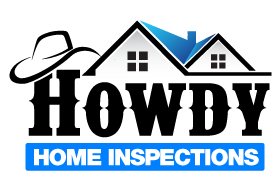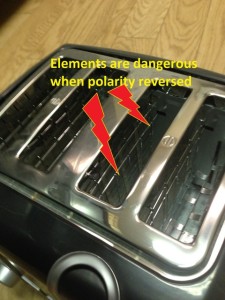One of the most common problems I find when inspecting houses are receptacles that have reverse polarity. Reverse polarity is basically where the “hot” wire is connected to the spot on the receptacle where the “neutral” wire should be and the “neutral” wire is connected to the spot where the “hot” wire should be. Essentially, the two wires are reversed. If you look at a receptacle, you’ll see there are two vertical slots that an appliance plugs into. The neutral, white wire is connected to the terminal of the longer slot and the “hot” wire is connected to the shorter slot. The “hot” wire is usually either black or red.
One reason I find so many outlets with reverse polarity is that replacing old outlets with newer ones is one of the easiest and least expensive ways a homeowner can clean up the look of their house. Lets face it, nothing looks better than a room with a bunch of bright, white outlets. Also, it wasn’t until 1962 that receptacles with equipment grounds (3 prong) were even required. That means there are still a lot of old, ugly two prong-ers out there waiting to be made pretty again.
Any time you switch out a receptacle, it’s critical that the new receptacle is wired properly. Even though an outlet whose polarity is reversed will still work, it still creates a shock hazard, which could have easily been avoided. There are other issues besides reverse polarity when you start switching two prong outlets to three prong-ers, but we’ll save those for a different blog post.
The Scoop on Hot and Neutral Wires
Electricity moves through your home on two different wires. The “Hot” wire is usually either black or red and carries electricity from the panel box to all the different areas of your house. This is called the “ungrounded conductor.” Once the electricity has done it’s thing, the neutral wire carries the unbalanced load back to the panel box. Because of this, the “neutral” wire is called the “grounded conductor”
When a receptacle is hooked up correctly, the flow of electricity to an appliance on that receptacle is interrupted when the switch is in the “off” position. When it’s switched “on” electricity flows and the appliance has power to do whatever it needs to do. However, when the polarity is reversed on a receptacle, the appliance’s “hot” wire is connected to the neutral terminal on the receptacle. While the appliance will still turn “on” and “off” it is no longer protected by that neutral wire. Your body now becomes the “grounded conductor” and is the pathway the electricity will take to complete the circuit. This is a very dangerous situation.
When Toasting a Waffle Becomes Deadly
Let me give you a real world example of the dangers of reverse polarity. Have you ever been making a waffle in the morning when the waffle gets caught in the toaster, instead of popping out likes it’s supposed to? What do we do when this happens? We take our fork and stick it down into the toaster to pry that waffle out. Doing this when the toaster is plugged into a receptacle with correct polarity is no problem. We have the neutral wire of the toaster connected to the neutral wire of the outlet. The appliance is “grounded” by the neutral wires and we are safe to stick our forks down there to get the waffle.
But when we do this with a toaster that is plugged into an outlet where the polarity is reversed, that neutral wire is essentially the hot wire. Instead of stopping the flow of electricity to hot wire, it is actually stopping it to the neutral. This means that while the heating elements inside the toaster look “off” because they aren’t glowing hot, they still have electricity running through them. So when we go to stick our fork in the toaster to get our waffle, the fork touches the sides of heating element and the electricity travels from the toaster, up your fork, up your arm, through your body and back into the ground through your feet. You have unknowingly completed the circuit and have become a victim of electrical shock.
How to Find and Fix Reverse Polarity
The easiest way to find out if a receptacle has reverse polarity is to buy a receptacle tester from your local hardware store. They cost about ten dollars and have three different lights on the end that light up when you plug it into an outlet. The different combinations of lights that are displayed on the tester indicate how the outlet is wired. When the polarity is reversed the red light and middle, yellow light both come on.
Once you find that you have an outlet with reverse polarity, it’s best to call an electrician to come out and correct the problem. Most of the time the problem can be corrected by switching the hot and neutral wires (after cutting of the power at the breaker). However, sometimes the hot and neutrals can be connected correctly on a receptacle, but the polarity will still be reversed. In a situation like this, an electrician can do a more in depth investigation to find out where upstream the problem originated.
Be Happy and Be Kind,
T.J. Thorne








